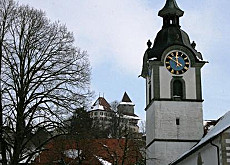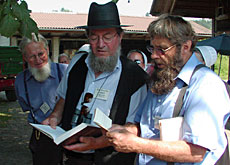Singing Swiss folk songs the American way

A CD released this year of old Swiss folk songs highlights the debt the Swiss owe North American communities for preserving part of their cultural heritage.
The CD, Amish Lieder/Amish Songs, includes songs brought to North America by members of the religious community who fled persecution in Switzerland between the 16th and 19th centuries.
The Bern-based publisher, Zytglogge, produced the recording to help mark a series of events commemorating the canton’s Anabaptist Year.
The aim of the year is to highlight the history of the movement – today divided mainly into the Mennonite church and Amish groups.
Faced with persecution for their refusal to recognise the state-run church and practice of adult instead of infant baptism, many Anabaptists went into exile in North America.
Some of the more conservative groups still speak a Swiss-German dialect and have kept alive Swiss folk songs.
“Singing is the only way the Amish can express themselves musically since they are not allowed to play instruments or listen to recordings,” said Brigitte Bachmann-Geiser, an ethnomusicologist from Bern.
She explains that every Amish church service begins with an hour of song. But community members also sing while they work: “They love to yodel whether they are doing their washing, sewing, peeling vegetables or taking in the corn harvest.”
Some of the yodel songs appearing on the CD – which ironically the more conservative Amish cannot listen to – are performed by Fannie Klockner, who grew up in an Amish family but left the community when she was 32.
Swiss Days
Klockner developed her passion for music as a child and always won the singing competition at the Swiss Days event in Ohio.
“She probably took her decision [to leave] because she simply wanted to sing and cash in on her success, which wasn’t possible within the Amish community,” Bachmann-Geiser said.
The musicologist is interested in the fact that the Amish have kept alive songs in the Bernese version of Swiss-German which are found neither in printed form nor in folk music archives.
“I’m proud that I was able to bring two songs back to the old world from the new,” she said. An example is “My Vatter isch e Chäser gsi” (My father was a cheese maker), which she assumes was never written down because it’s “an erotic dance number”.
Martyr song
The most prominent number on the CD is the Haslebacher song, a 32-verse ballad about the farmer and leading Anabaptist who in 1571 was the last member of the radical movement to be executed in canton Bern.
The song is believed to date back to the 17th century and portrays the plight faced by the persecuted Christians at the time. The words have been preserved in the so-called “Ausbund”, the oldest hymnbook still in use.
The “Haslebacher-Lied” was recorded by a more moderate Amish group in Ephrata, Pennsylvania.
“[The recording] was presented as a gift to Hans Haslebacher, the direct descendant and namesake of the executed preacher, from 200 temperate Amish as a way of saying thanks for his generosity when Mennonites or Amish visit the farm of the well-known martyr,” said Bachmann-Geiser. “They presented it to him during a visit he made to the United States.”
“Secret language”
The CD includes a second version of the Haslebacher song which originally appeared on the Röseligarte (rose garden), the biggest collection of Swiss-German songs recorded at the beginning of the 20th century.
This version was interpreted by three singer-songwriters who attained a degree of success in the Swiss folk music scene at the end of the 1970s: Urs Hostettler, Martin Diem and Luc Mentha.
Bachmann-Geiser’s research concentrates on the communities south of Berne, Indiana. The Old Order Amish there have preserved the dialect of their ancestral homeland. “Their Bernese dialect could be described as a secret language,” she said.
Despite their beliefs and lifestyle, she says they are still influenced by modern American culture.
“I’m convinced that they will slowly lose their language and one day it will completely disappear.”
swissinfo, Gaby Ochsenbein
The CD Amish Lieder/Amish Songs can be ordered online from Swiss publisher, Zytglogge Verlag (see related sites).
Yodel songs are performed by Fannie Klockner, an American singer and former member of an Amish community.
The 44-minute collection also includes two versions of the Haslebacher-Lied, one performed by Amish in Pennsylvania and the other by Swiss folk singers.
The CD includes an informative booklet in German and English.
There are around 150,000 Amish spread across the United States, Canada and Mexico.
The Amish of Berne, Indiana, speak a dialect they call “Amish” – closely related to the Bernese version of Swiss-German.
As part of Anabaptist Year, events are being held throughout canton Bern and other parts of northwestern Switzerland to remember the persecution of members of the movement.
Important sights in the Jura region include the “Anabaptist Bridge” located in the hills above the village of Corgémont, and the archives kept in the Jeangui Chapel belonging to the Sonnenberg congregation.
Visitors from abroad are being encouraged to attend an international gathering in the Emmental from July 26-29.

In compliance with the JTI standards
More: SWI swissinfo.ch certified by the Journalism Trust Initiative




You can find an overview of ongoing debates with our journalists here . Please join us!
If you want to start a conversation about a topic raised in this article or want to report factual errors, email us at english@swissinfo.ch.